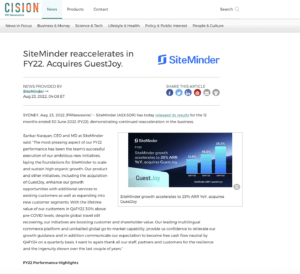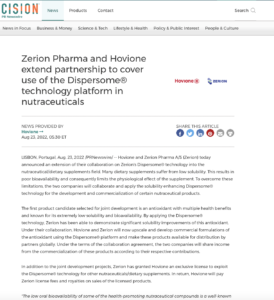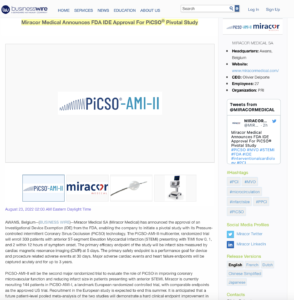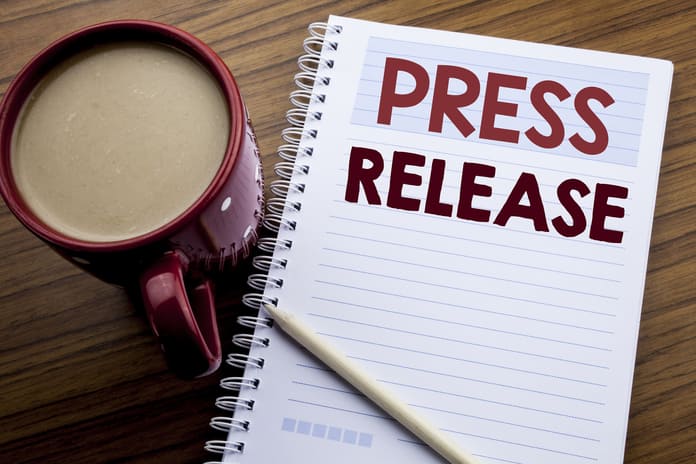Knowing different press release types will not only help you write better press releases, it will also help your audience be more engaged.
Business marketing has come a long way since the days of print ads and TV commercials. In the digital age, the press release is one of the most effective tools in a marketer’s arsenal.
Press releases can come in many different formats, but all have one common goal : to get the media’s attention and attract potential customers. In this quick guide, we’ll look at what press releases are, the different types, and some examples of effective ones.
What Is A Press Release?
A press release is a written or recorded communication directed at news media members to announce something ostensibly newsworthy. Typically, a press release contains at least one quote from a person involved with the subject of the release.
A press release can be prepared by an individual, company, or organization to promote their work or products, announce a new hire, or gain media attention for an upcoming event. While most press releases are sent to media outlets electronically, some organizations still send them by fax.
Other terms people call a press release are a news release, press statement, and media release. A well-written press release can be the difference between a media outlet covering your story and ignoring it. Think of a press release as a tool in your marketing toolbox. By using them wisely, you can get free publicity for your business.
Why Do You Need A Press Release?
If you’ve ever wondered how to get the name of your business in the news, you’ve thought about writing a press release. Press releases are a fantastic way to spread the word about your company and its goods or services, even though it may appear like an arduous undertaking.
By sharing newsworthy information about your product or service with the media, you can generate excitement and interest without spending a dime on advertising. Press releases help generate buzz for your business.
Of course, not every story is newsworthy, and not every journalist is interested in every story. That’s why it’s essential to understand the purpose of a press release and how to use it effectively.
A press release should be used to share timely, relevant information that will interest the media outlet’s audience. It should be well-written, free of grammatical errors, and include all of the essential information (who, what, when, where, why) that a reporter would need to write a story.
Press Release Types
There are all sorts of press releases out there. Some are designed to generate media attention, while others simply inform the public.
But what all press releases have in common is that they need to be well-written and newsworthy. Here are some of the most popular types of press releases:
- Product announcements: These press releases generate buzz around a new product launch. They should be packed with information about the product, including its features, benefits, and pricing.
- Event announcements : Press releases announcing upcoming events are a great way to generate interest and excitement. Include all the relevant details, such as the date, time, location, and expected attendees.
- Awards & recognitions: Getting recognized by an industry association or other organization is a great way to build credibility for your business. If you’ve recently been honored with an award or distinction, let everyone know with a press release.
- Company news: From new hires and promotions to Expansion plans and partnerships, there’s always something new happening at your company. Keep the public informed with periodic company news updates.
- Industry news: If you’re an expert in your industry, you can use press releases to share your insights and observations on current trends. This is a great way to position yourself as a thought leader in your field.
- Merger & acquisition: Anytime your company makes a significant change, such as merging with another business or acquiring a new one, it’s vital to share the news with the public. Merging with another business could also be a form of partnership.
- Rebranding: If your company is undergoing a rebranding effort, you’ll want to announce the news with a press release. This is also an excellent opportunity to share your new logo and tagline.
- Business launch: A business launch press release is a great way to generate buzz around your new company. This type of press release provides information about the new business, its products or services, and its founders.
What Is the Press Release Format?
When it comes to the press release format, there are a few essential elements that should always be included:
- A catchy headline: The headline is the first thing a reporter will see, so it’s essential to make it count. Keep it short and sweet, and include key keywords to help your press release get found online.
- The dateline: This is a press release’s second most crucial element. It should include the city and state where the press release originated and the date.
- The body: The body of the press release should be clear and concise and include all of the essential information reporters need to write a story. Be sure to include quotes from key stakeholders and any relevant data or statistics.
- The boilerplate: The boilerplate is a short, informative paragraph that provides reporters with additional information about your company. This is a great place to include your company’s history, mission statement, and contact information.
- The media contact: Include the name, phone number, and email address of the person who reporters can contact for more information.
What Makes a Good Press Release?
A good press release tells a compelling story and includes all of the essential information that reporters need to write a news article. But what else sets a good press release apart? Here are a few things to keep in mind:
- A good press release is newsworthy: Remember, the whole point of a press release is to get reporters to write about your story. So, it’s essential to make sure your press release is newsworthy. This means it should be timely, engaging, and relevant to the reporter’s audience.
- A good press release is well-written: A press release is not an advertisement or a sales pitch. It’s a news story, so it should be written in a journalistic style. This means using short, concise sentences and an active voice.
- A good press release is targeted: Not every reporter will be interested in your story. That’s why it’s essential to target your press release to reporters who cover your industry or beat. This way, you’re more likely to get coverage from reporters interested in what you have to say.
- A good press release is distributed properly: If you want your press release to be read by reporters, you must ensure it’s distributed through the proper channels. This means using a reputable press release distribution service, such as PR Newswire, Business Wire, or Press Reach.
5 Tips For Distributing Your Press Release
Now that you know what makes a good press release, it’s time to start distributing your own. Here are five tips to help you get started:
- Start by creating a list of target publications: Before you start sending out your press release, make sure you have a list of target publications in mind. This will help you focus your distribution efforts and increase your chances of getting coverage.
- Personalize each pitch: When you’re sending out your press release, take the time to personalize each pitch. This means tailoring the message to fit your target publication or reporter.
- Follow up: Once you’ve sent out your press release, don’t just sit back and wait for the coverage to come rolling in. Follow up with each reporter or publication to ensure they received your release and see if they have any questions.
- Measure your results: After you’ve distributed your press release, measuring the results is essential. This will help you determine what’s working and what’s not, so you can make adjustments for future releases.
- Get creative: There’s no one right way to distribute a press release. So, don’t be afraid to get creative and experiment with different distribution channels. You never know where you might find your next big break.
By following these tips, you can ensure that your press release is distributed properly and has the best chance of being read by reporters. And, who knows? Maybe your next big story will be just around the corner.
Press Release Examples
In this section, we’ll show you three press release examples used to generate business coverage. You’ll notice these examples follow the format we discussed in this article.
SiteMinder reaccelerates in FY22. Acquires GuestJoy.
1. Type of press release : Acquisition

This press release from SiteMinder announces their acquisition of GuestJoy, a customer engagement platform for hotels. The release is newsworthy, well-written, and targeted at reporters who cover the travel and hospitality industry.
2. Zerion Pharma and Hovione extend partnership to cover use of the Dispersome® technology platform in nutraceuticals
Type of press release : Acquisition

This press release from Zerion Pharma announces their extension of a partnership with Hovione, a pharmaceutical company. The release is newsworthy, well-written, and targeted at reporters who cover the pharmaceutical industry.
3. Miracor Medical Announces FDA IDE Approval For PiCSO® Pivotal Study
Type of press release : Product announcement

This press release from Miracor Medical announces FDA IDE approval for their PiCSO® pivotal study. The release is newsworthy, well-written, and targeted at reporters who cover the medical device industry.
As you can see, these press releases follow the same basic format. They include a headline, dateline, location, introduction, body, and boilerplate (at the end). They are also all newsworthy, well-written, and targeted at reporters who cover the respective industries.
FAQs about press releases
Q : How long should a press release be?
A : A press release should be one page or about 400 words. Remember that reporters are often pressed for time, so you’ll want to ensure that your press release is concise and to the point.
Q : When should I send out my press release?
A : It’s generally best to send out your press release as early as possible. That way, reporters will have the opportunity to write about your story before their deadlines.
Q : How do I format my press release?
A : Your press release should be formatted as a simple document with no fancy graphics or formatting. Stick to plain text and include all the vital information (date, time, location, etc.) in the first few paragraphs.
Q : Who should I send my press release to?
A : You’ll want to send your press release to local media outlets, as well as any relevant industry publications. If you’re not sure who to contact, you can always reach out to a local PR agency for help.
Q : What else should I include in my press release?
A : In addition to the basics (date, time, location, etc.), you’ll also want to include a quote from someone involved with the event or story. This will give reporters some additional context and make your press release newsworthy. You should include a call to action (e.g., “For more information, please visit XYZ.com”).
Q : What’s the best way to distribute my press release?
A : There are several ways to distribute your press release, but the most effective method is through an online newswire service. This will ensure that your press release reaches the widest possible audience.
Q : How much does it cost to distribute a press release?
A : The cost of distributing a press release varies depending on the newswire service you use. However, most services will charge a flat fee for distribution.
Q : I’m not sure if my story is newsworthy. What should I do?
A : If you’re not sure if your story is newsworthy, it’s always best to err on the side of caution and consult with a local PR professional. They’ll be able to give you some guidance on whether or not your story is worth pitching to the media.
Featured Image: Megapixl © Arturszczybylo











